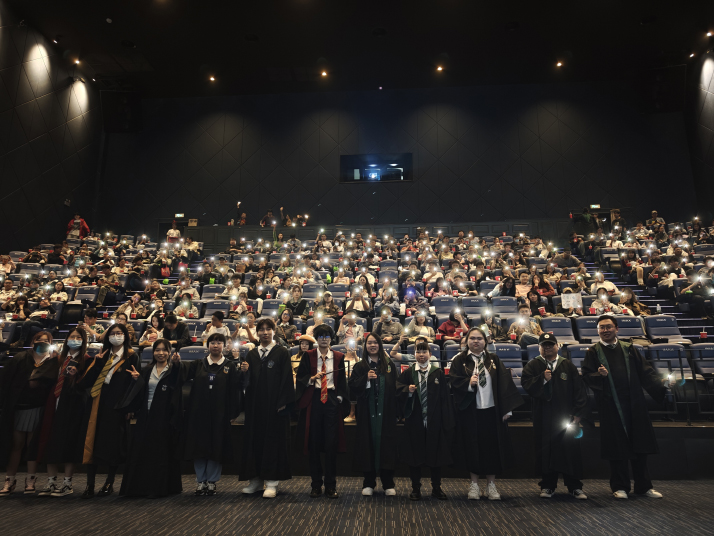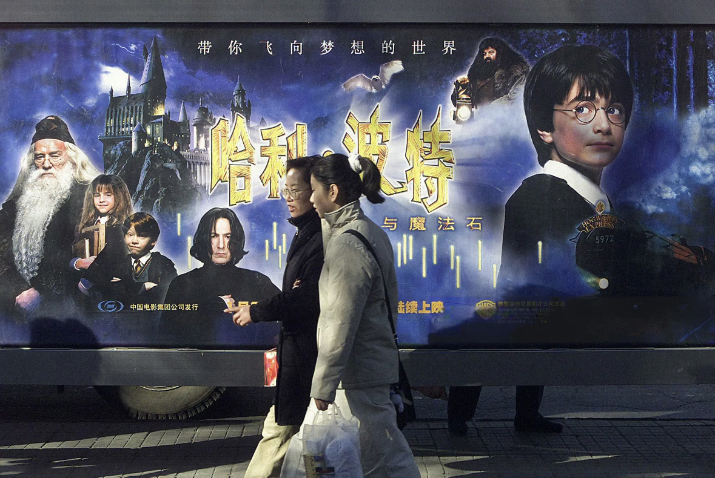| China |
| Harry Potter and the broader revival of 'vintage' films at the Chinese box office | |
|
|
 Viewers pose for a group photo after a fan-exclusive screening of Harry Potter and the Sorcerer's Stone in Zhengzhou, Henan Province, on October 13 (PROVIDED BY FJHFELIX ON XIAOHONGSHU)
Twenty-two years after its initial release in China, the Harry Potter screen saga is casting another spell on the country. All eight films in the series are slated for a wide re-release in some 3,400 theaters across 295 Chinese cities. The theatrical run kicked off on October 11 with Harry Potter and the Sorcerer's Stone and will continue with the consecutive screenings of its seven other titles, which will drop every week through October and November. Besides the original 2D version, the entire series will also be available in multiple premium formats, including IMAX, Dolby Cinema, and CINITY, a China-developed projection system. The re-release comes on the heels of a bleak box office season during the National Day holiday, from October 1 to 7, a traditional high time for moviegoing in China. This year, however, ticket revenue over the seven-day break fell 23 percent short of last year, Chinese ticketing platform Maoyan reported. Amid a string of box office blues, the first Harry Potter film took up almost a quarter of ticket sales at Chinese cinemas by raking in over 10 million yuan ($1.4 million) on its first day of re-release alone, despite a modest 6-percent share of screenings nationwide. Many believe this is only the beginning of a frenzied box office spree, as Potterheads nationwide have mobilized to organize nothing short of an extravaganza, with fan-exclusive viewing groups and movie marathons popping up all over the country. It seems like the bespectacled boy has once again begun to work his magic. Back to Hogwarts "This is my eighth time watching the first Harry Potter film, and yet it never gets old," Yang Hui, a 29-year-old freelance translator and die-hard Harry Potter fan who went to see the film on day one, told Beijing Review. Even these days, Yang can still recall the fascination he felt as a 7-year-old when he first watched the film on a borrowed DVD. The screen was flaky, the resolution insanely low, but the movie introduced him to a universe that expanded his imagination beyond Chinese fables and fairytales. Yang belongs to what social media refers to as the "Harry Potter generation," a generation of millennials and Gen Zs who grew up with the series, for whom every phase of their coming of age was marked by a new Harry Potter film. "Every generation has its own safe of shared cinematic memories. For my generation, Harry Potter is one of those cultural touchstones that have come to define us," Yang said.  A poster of Harry Potter and the Sorcerer’s Stone on a bus stop shelter in Beijing on January 16, 2002. The film was released in China on January 31, 2002 (PROVIDED BY AHE ON XIAOHONGSHU)
For Yang and many of his peers, the movies were their first taste of Western fantasy flicks, dating back to a time when a huge influx of foreign films was beginning to transform China's theatrical sector into the global box-office powerhouse it is today. "The series was my first contact with international cinema. It drew me into the orbit of global pop culture back when I was just a little kid growing up in a small Chinese town," a comment on Chinese review platform Douban read. The franchise's return to Chinese cinemas, however, is not just a nostalgic nod to the collective memories of one generation but also an invitation to newcomers. "There is a whole generation of Chinese audiences who have not had the chance to enjoy the Harry Potter movies in theaters," Kurt Reider, head of theatrical distribution in the Asia-Pacific region at Warner Bros. Pictures, the studio behind the franchise, said at a media conference in Indonesia. During the screening on October 11, Yang was surprised to note that a large portion of the audience was Generation Alpha—children who were born after the last Harry Potter film came out in 2011. It is not just about revisiting old times, but also about creating new memories, he said. A cinematic renaissance It is not uncommon for restored classics to return to Chinese theaters. In 2012, a 3D rendition of James Cameron's Titanic landed with the biggest opening of all time in the Chinese box office. The flick eventually took a staggering 1 billion yuan ($140 million) in ticket sales, a feat that drew the attention of domestic and foreign studios alike to the vast potential of the Chinese film market. But the trend really took off in 2020, a year in which the COVID-19 pandemic brought virtually all film productions worldwide to a standstill and subsequently triggered a drastic drop in new releases. As Chinese cinemas slowly recovered from pandemic closures, a slate of older films was dug up from the archives to fill the voids in the movie calendar. "There has been a pent-up appetite for cinematic content, which has fueled a surge in demand for old-time favorites to be remastered in 4K and high dynamic range (HDR) formats," Chen Lufan, a Beijing-based film producer, told Beijing Review. According to statistics published in China Business Journal, since 2012, some 30 classic movies have been re-released in Chinese theaters, among which more than 20 were shown after the onset of the pandemic. As domestic theaters began to expand their offerings beyond new titles, yeqinghui, which translates to "my youth is back," became a viral catchphrase for the mass revival of older movies. In 2020, it was selected as the word of the year by Chinese YouTube equivalent BiliBili, where the phrase had flooded the comment sections under trailers of returning classics. Most re-releases are Western pictures across a wide spectrum of genres. The league includes Inception, Avatar and other Hollywood action blockbusters, musicals such as La La Land, and older classics from the film canon, including The Legend of 1900 and Cinema Paradiso. This legion of cult classics has been enlisted to help foreign studios regain their foothold in the world's second largest film market, which has increasingly gravitated toward local titles that better cater to the tastes of Chinese audiences. Apart from these foreign classics, a slew of domestic films, many of which did not receive much success during their original run, have been re-released over the past decade. In 2017, a restored version of A Chinese Odyssey: Part 2-Cinderella, a 1995 fantasy film starring Hong Kong comedian Stephen Chow, became the highest-grossing re-release in the history of Chinese cinema. The film, a complete flop when it first came out, earned a colossal 175 million yuan ($25 million) in its second round. Partial revival For Chen, the rise of repertory cinema in China is a sign of a maturing film market. "Chinese theaters are shifting away from fixed box office seasons to a 'supermarket' mode of theatrical releases, where movies of all times from all around the globe are easily accessible," Chen said. "It's less about what is new and more about giving viewers the freedom to choose." However, the industry has not entirely caught up with the changes taking place. And the return of Harry Potter to the big screen has brought to the fore the many pitfalls lurking beneath this trend. "I was actually a bit disappointed after watching the film," Yang said, noting that the image quality of the re-mastered version is not much different from that of the original. This sense of disenchantment is widely echoed throughout Chinese social media, where fans have been complaining about both the picture quality and numerous mistranslations they detected in the subtitles, which remain unchanged at all from the 2002 version. "For a film to be restored, it will have to find a balance between making improvements and preserving the original touch," one Douban review stated. The re-release has also sparked widespread controversy, as many moviegoers in smaller cities said they couldn't find local screenings. According to statistics released by film tracking site Dengta, smaller cities accounted for only 30 percent of the theaters re-releasing the film. "Regional imbalance is still very much present in domestic film distribution," Lianchengyicui, a data analyst and influencer, said on social media platform Weibo, adding that China is still in the elementary phase of fostering a data-driven film industry. "In the future, we should better harness the power of big data to dissect audience behavior, identify target markets and develop more tailored distribution strategies," he concluded. (Print edition title: From Safe to Screen) Copyedited by Elsbeth van Paridon Comments to pengjiawei@cicgamericas.com |
|
||||||||||||||||||||||||||||
|